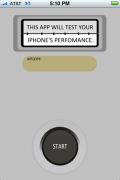| Available In: App Store | Price: $1.99 |
![]() Ever since converting from a Windows Mobile device, I have been extremely impressed with how well the iPhone handles the opening and closing of so many different applications. With all of my previous Windows devices, I would always have to perform a soft reset every so often, and the more programs I installed and opened, the more frequently these soft resets were required. Since owning the iPhone, I’ve performed only a handful of resets (power off/on) and I can easily go weeks without ever shutting down the phone. Thus, I’ve wondered what exactly is going on under the hood, so to speak, with the iPhone.
Ever since converting from a Windows Mobile device, I have been extremely impressed with how well the iPhone handles the opening and closing of so many different applications. With all of my previous Windows devices, I would always have to perform a soft reset every so often, and the more programs I installed and opened, the more frequently these soft resets were required. Since owning the iPhone, I’ve performed only a handful of resets (power off/on) and I can easily go weeks without ever shutting down the phone. Thus, I’ve wondered what exactly is going on under the hood, so to speak, with the iPhone.
Overview
With Diagnostics, you get a quick snapshot of how your iPhone is performing, as the application relies on a single measurement called MFLOPS (Mathematical Floating Operations Per Second). While I’m no computer expert, a quick Google search reveals that MFLOPS is a common benchmark used to measure a computer’s performance power, though there is some disagreement among experts about the relevance of such a measurement. The Diagnostics app takes about 30-45 seconds to measure your MFLOPs, and gives you a reference for what is considered to be a normal value.
All Systems Go.
Well, I can’t say that I needed an instruction manual for this app. With only one button on the screen, our two cats could successfully run Diagnostics with ease. I could almost argue that they are also able to interpret the results since the data revealed by Diagnostics is rather limited. I was able to get a sense of the application’s usefulness by testing my iPhone both before and after using the iPod feature. Clearly, having the iPod running in the background slows down your iPhone a bit, and with Diagnostics, I now have the data to affirm that statement.
But, what’s the cure?
So, unless you want to test your iPhone after running each application and compile the data into a nice table, chart, or graph, what is Diagnostics really going to do for you? I’m not sure, honestly. The developer states that updates will include a graph and the past 5 test results. This would be nice statistically speaking, but true value will come from the developer’s ideas of testing other parts of the iPhone (battery, memory, screen) and being able to actually optimize your iPhone by freeing memory or improving the efficiency of the processing speed. As noted by the developer, Apple is keeping a tight grip on this functionality, so we’ll see if this ever happens.
Troubleshooting the price
As mentioned above, I’m not too impressed with Diagnostics in its current incarnation. I certainly would not recommend buying the app for $1.99. With additional updates, more options to troubleshoot and optimize, and faster results, I could potentially see a $0.99 price justified. I will acknowledge that there is a significant amount of upside for apps such as Diagnostics, especially as more and more apps continue to flood the store, and users continue to load their phones with these programs.







I’m afraid MFLOPS will be a flop at $1.99!!
Sorry, Scott
But apps should be more expensive than a frosty.
Well, Maybe?
Douglas, I’m glad you graduated from Windows devices. I really dislike them and I’ve used many – many. I hate the ugly little icons and the totally outdated OS, despite recent updates. I deplore things like mail that doesn’t send instantly (I know, I know, it can be done). I just think it’s a third rate system.
The reason the iPhone handles the opening and closing of applications so well is due to the fact that they only allow a few apps to stay backgrounded. Windows Mobile devices needed soft resets due to poor memory management ad well as the fact that few apps were ever closed automatically. That’s what I liked most and like least about the iPhone. With WM I could move around apps without having to get back to where I was due to them thinking I wanted it closed. I wish Apple would allow us to switch between open apps without having to restart.